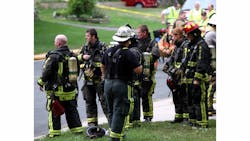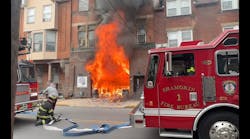Perhaps the most difficult task you’ll face as an instructor is keeping your department engaged in drills and lectures. The first thing you need to do is to evaluate your audience and figure out what you're up against. But regardless of the subject, some factors — such as morale, attitude and leadership — are out of your control. This can turn a valuable training opportunity into an “all that’s wrong with the world” complaint session.
So what can you do? The easy answer: start with the people. They should be committed, respectful and attentive. As professionals, they should show the initiative to improve their skills in any area.
OK, let’s get back to the real world. Every firefighter is driven by (and responds to) different challenges. These challenges can come in the form of goals or threats. The key is to know how to approach your members in a way that gets the most out of them. Training from the “1/3 Concept” is one way to accomplish that goal.
In the 1/3 Concept, all of the members of your organization fall into one of three groups: the lower third (or "I knows"), the middle third and the upper third (go-getters). The hard part is that the populations in these different groups are not defined into 33% pieces; they are constantly changing. Finding a healthy balance at every level is not an easy thing to do, but neither is being a leader.
The first group is the bottom third, or "I knows" of your organization. Just because some members of your organization are in this group doesn’t mean they’re “bad” or incompetent in any way. In fact, they’re often the easiest group to influence and improve. The individuals in this category are usually there for one of the following reasons:
They’re new on the job – they lack the general knowledge and comfort with their skills to jump right into your training program. The biggest mistake you can make with this group is to customize your training down to their level. This will do nothing but hold back your organization from getting better every time you have a hiring. As a trainer, you need to assess what you are getting as a raw recruit, and then evaluate how they were being trained before you got them. I’m not telling you to throw them into the deep end and see what happens. But you can pair them with a veteran firefighter as their “swim buddy” and see how quickly they come up to speed. (This will tell you a lot about how well the fire academy or local Firefighter I class is being taught. If you’re not happy with the product you are getting, follow up. Remember — you are the customer!)
They’re unmotivated – Let’s face it, not everyone in your organization is firing on all cylinders. Some firefighters spend their careers coasting through classes and standing in the back of the room during hands-on drills. Many instructors and officers will tend to ignore these people, just to avoid the hassle. Well, you can’t – you need to hold them accountable for the information as much as the eager-to-learn newbie sitting in the front row. Try to build something into your course that shows every student understands the subject material. Ask questions as you go. Involve otherwise uninvolved participants in the discussion. Bring everyone into the conversation. When a trainee can see you’re informed on your subject, they’re more likely to pay attention – or even try to challenge your knowledge. Be ready for both. At some point, certain individuals may need some one-on-one work to get their skills or knowledge base up to speed. The officers in your organization will be your biggest help with this group. Work with them to find what motivates these underperforming firefighters, and then use it to your collective advantage. Discipline is rarely the answer.
They’re tuned out – every department has (at least) one: a firefighter who’s become disinterested with the organization and is hanging around for the pension. These jaded, cynical veterans are the hardest individuals you’ll deal with as a trainer. They’re usually knowledgeable and respected for their years of service, but something happened along the way that changed their original reason for becoming a firefighter. The only way to bring them back is to show them they’re still valued within the organization. Every organization needs trusted, experienced mentors. With your help, they should either find the right reasons to re-engage, or move on. Firefighting is an honorable profession with deep moral commitment and passion for the job. Sometimes egos and misdirected motivations lead some people to make dangerous decisions. Don’t sit by and let this happen in your department.
Let’s switch gears and discuss the upper third of your department. You’re probably already picturing these folks in your head: the “go-getters,” the members who are always on the lookout for new challenges and hungry for the knowledge that comes with them. Because this group usually consists of senior firefighters, officers and trainers, you might think they don’t need much attention. But you would be wrong. This group must be continually challenged in order to improve, and this is where most departments fall short.
The moment an individual becomes an officer – or even gets a reputation as someone who knows what they’re doing – organizations have a tendency to stop challenging them. Look at the training offered in your area: Are there any courses designed for the 10-year-plus firefighter? Are there courses that help you develop as a fireground leader, or are you expected to know it all when you get that shiny new badge?
The moment you start dumbing-down your training program, you will begin to lose your upper third. It won’t happen overnight, but rest assured it will happen. Let the people who drive your organization do just that. Keep these high performers engaged. Send them to a seminar or training course, and then ask them to help develop training associated with it. If your organization just assumes this group is fine and dandy, then be prepared to see it shrink to near-extinction.
And then there’s the final third: the middle group. This group usually makes up the majority of your membership, and consists of individuals who have moved from one of the other groups. They’re either benefiting from your training program and moving up through the ranks, or they’re burning out and sliding into the bottom third.
The goal of any organization should be similar to the goals of any healthy community in this country: an upwardly mobile population that is primarily middle-class. Realize that the lower third needs your honest help – not handouts and a blind eye – in order to climb into the middle class. The upper third should constantly be revaluating where they are headed and if that aligns with community and departmental needs.
By using the 1/3 Concept to sort your membership into groups, then identifying the strengths and weaknesses of each, you can design a training program that engages and challenges every member of your department.
DEREK PETERSON has been in the fire service since 1991. He is currently a captain and paramedic with the Saint Paul, MN, Fire Department. Peterson has been a certified fire instructor with various technical colleges and training institutions for the last 18 years. He acts as the lead instructor for the St. Paul Fire Department's technical rescue program and has assisted with the department’s training academy since 2005. He has developed courses on apparatus operation, rapid intervention, company operations, incident command for technical rescue, advanced strategies and tactics, and crew integrity. He is a medical specialist and trainer with the regional Urban Search and Rescue Team, Minnesota Task Force 1. Prior to joining St. Paul, he served as a firefighter and trainer for the cities of Coon Rapids and Eden Prairie, MN.






